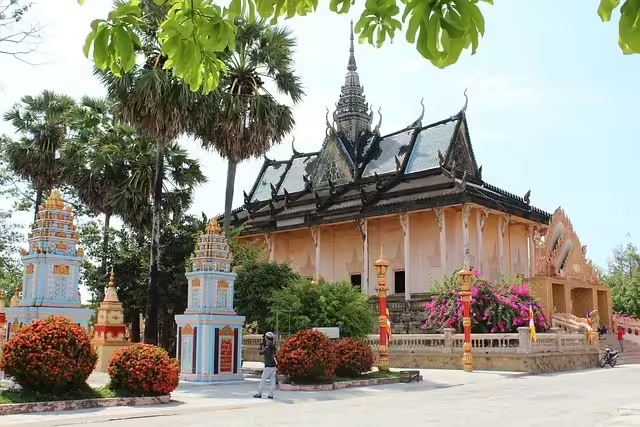
Introduction:
Planning a Best time To Travel in Vietnam and Cambodia promises an adventure filled with rich history, vibrant culture, and breathtaking landscapes. However, to make the most of your journey, it’s essential to consider the best time to visit these captivating destinations. Each season offers a unique experience, whether you’re exploring ancient temples, cruising along picturesque rivers, or indulging in delectable cuisine. Let’s delve into the seasonal nuances to help you plan your dream getaway.
Spring (March to May): Best Time to Travel
- Vietnam: Spring brings pleasant weather to most parts of Vietnam, making it an ideal time to explore cities like Hanoi and Ho Chi Minh City. The temperatures are mild, and the landscapes are lush and green after the winter rains.
- Cambodia: Spring marks the end of the dry season in Cambodia, offering comfortable temperatures for exploring iconic sites like Angkor Wat. It’s advisable to visit before the scorching heat of summer sets in.
Summer (June to August): Best Time to Travel
- Vietnam: Summer brings warmer temperatures and occasional rainfall, particularly in central Vietnam. Despite the humidity, this season is perfect for beach lovers, with destinations like Da Nang and Nha Trang offering pristine shores and water activities.
- Cambodia: Summer in Cambodia signals the beginning of the rainy season, characterized by brief but heavy downpours. While the countryside is lush and vibrant, it’s essential to be prepared for intermittent showers when exploring outdoor attractions.
Autumn (September to November): Best Time to Travel
- Vietnam: Autumn is considered one of the best times to visit Vietnam, with pleasant weather and clear skies across the country. This season is perfect for exploring the stunning landscapes of Ha Long Bay, Sapa, and the Mekong Delta.
- Cambodia: Autumn brings relief from the rains in Cambodia, offering cooler temperatures and clear skies. It’s an excellent time to visit both cultural sites and natural wonders like Tonle Sap Lake and the Cardamom Mountains.
Winter (December to February): Best Time to Travel
- Vietnam: Winter brings cooler temperatures to northern Vietnam, making it an excellent time to explore Hanoi, Sapa, and Ha Giang. Meanwhile, central and southern regions enjoy mild weather, perfect for visiting destinations like Hoi An and Ho Chi Minh City.
- Cambodia: Winter is the peak tourist season in Cambodia, thanks to the dry and comfortable weather. It’s an ideal time to explore the famous temples of Angkor and enjoy outdoor activities like boat cruises on the Mekong River.
Let’s break down the weather patterns for each month in Vietnam and Cambodia:
- January:
- Northern Vietnam: Cool and dry, with temperatures averaging around 17-22°C (63-72°F).
- Central Vietnam: Mild and dry, perfect for exploring cities like Hue and Hoi An.
- Southern Vietnam: Warm and dry, with temperatures around 25-30°C (77-86°F).
- February:
- Similar to January but with slightly warmer temperatures across the country.
- Northern Vietnam may experience occasional fog in mountainous areas like Sapa.
- March:
- Northern Vietnam: Gradually warming up with temperatures ranging from 18-23°C (64-73°F).
- Central Vietnam: Pleasant weather continues, ideal for visiting destinations like Da Nang and Nha Trang.
- Southern Vietnam: Warm temperatures persist, perfect for exploring Ho Chi Minh City and the Mekong Delta.
- April:
- Northern Vietnam: Warm and sunny, with temperatures climbing to 22-28°C (72-82°F).
- Central Vietnam: Hot and dry, with temperatures reaching 25-30°C (77-86°F).
- Southern Vietnam: Similar to March, with warm temperatures and low humidity.
- May:
- Northern Vietnam: Hot and humid conditions start to set in, with temperatures around 25-32°C (77-90°F).
- Central Vietnam: Hot and dry weather continues, ideal for beach activities in places like Nha Trang.
- Southern Vietnam: Warm temperatures persist, but humidity increases as the rainy season approaches.
- June:
- Northern Vietnam: Hot and humid, with occasional rain showers bringing relief from the heat.
- Central Vietnam: The rainy season begins, with frequent but short downpours in coastal areas.
- Southern Vietnam: The rainy season starts, bringing regular afternoon showers and increased humidity.
- July:
- Northern Vietnam: Hot and humid weather continues, with intermittent rain showers.
- Central Vietnam: Rainy season peaks, with heavy rainfall and occasional storms.
- Southern Vietnam: Rainy season persists, with frequent downpours and high humidity.
- August:
- Similar to July, with hot and humid conditions prevailing across the country.
- Central and southern regions experience heavy rainfall, leading to lush green landscapes.
- September:
- Northern Vietnam: Rainfall decreases, but humidity remains high, with temperatures around 25-30°C (77-86°F).
- Central Vietnam: Rainy season starts to subside, making it a good time to visit destinations like Hoi An.
- Southern Vietnam: Rainfall continues but gradually decreases towards the end of the month.
- October:
- Northern Vietnam: Dry and cooler weather returns, with temperatures averaging around 22-28°C (72-82°F).
- Central Vietnam: Dry season begins, offering pleasant weather for outdoor activities.
- Southern Vietnam: Rainfall decreases further, making it a great time to explore Ho Chi Minh City and the Mekong Delta.
- November:
- Northern Vietnam: Cool and dry conditions prevail, perfect for exploring cities like Hanoi and Sapa.
- Central Vietnam: Dry weather continues, making it an excellent time to visit UNESCO World Heritage sites.
- Southern Vietnam: Dry season begins, with comfortable temperatures and clear skies.
- December:
- Northern Vietnam: Cool and dry, with temperatures ranging from 17-23°C (63-73°F).
- Central Vietnam: Dry and mild weather, ideal for beach holidays in destinations like Da Nang.
- Southern Vietnam: Similar to November, with dry and pleasant conditions for outdoor activities.
Cambodia:
- January – March:
- Dry and cool weather prevails, with temperatures averaging around 20-30°C (68-86°F).
- Ideal for exploring Angkor Wat and other historical sites without the scorching heat of summer.
- April – May:
- Hot and dry conditions set in, with temperatures soaring above 30°C (86°F).
- While daytime temperatures are high, evenings offer some relief.
- June – August:
- The rainy season begins, bringing frequent downpours and high humidity.
- Despite the rain, it’s still possible to explore Cambodia’s attractions, albeit with occasional disruptions.
- September – November:
- Rainfall gradually decreases towards November, with cooler temperatures making outdoor activities more enjoyable.
- Ideal for exploring both cultural sites and natural wonders like Tonle Sap Lake.
- December:
- Dry and cooler weather returns, making it a popular time for tourists to visit Cambodia.
- Perfect for exploring Angkor Wat and other outdoor attractions without the discomfort of extreme heat or heavy rainfall.


